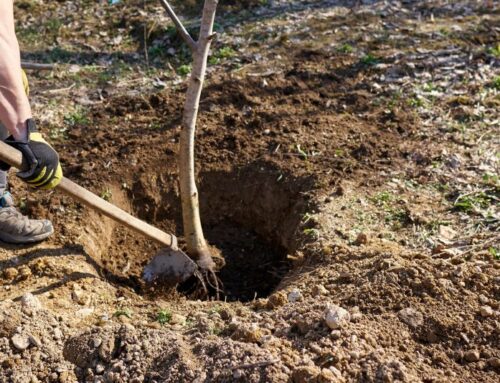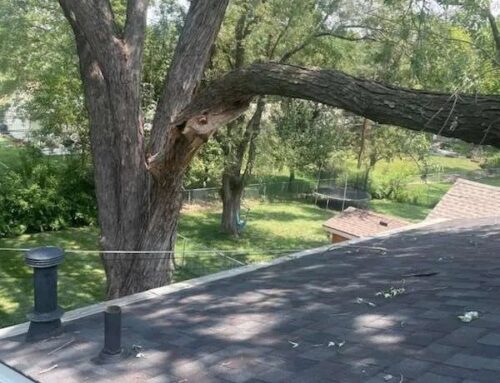Trees are a mainstay of our environment, providing us with oxygen, shade, and health benefits. They improve air quality, support wildlife, and beautify our landscapes. Yet, how well do you really know the trees around you? Understanding tree anatomy helps you appreciate them more and take better care of them. Let’s dive in and explore the seven key parts of a tree: roots, trunk, bark, branches, leaves, crown, and stump.
Why Should You Learn the Anatomy of a Tree?
By understanding a tree’s different parts, you can recognize signs of health or distress, identify symptoms of disease, and make informed decisions about pruning, planting, and overall maintenance. A healthy tree provides many benefits, from improving property value to reducing energy costs by providing shade. However, without proper care, trees can become susceptible to pests, diseases, and structural weaknesses. Knowing how to identify potential problems early can save you from costly repairs or removals later. Whether you’re a homeowner, gardener, or just someone who loves nature, learning about tree anatomy equips you to better support your trees.
The Different Parts of a Tree and Their Functions

Knowing the various parts of a tree helps you understand their functions and how they come together to support the entire woody organism. Here is a breakdown of each part of a tree.
Roots
Roots are the foundation of a tree, anchoring it in the soil and absorbing essential nutrients and water. There are several types of roots, each serving a specific purpose:
- Taproots: Most prominent in young trees, these grow deep into the soil, providing stability and accessing underground water. Mature trees frequently lack significant taproots, relying instead on lateral and absorption roots.

- Lateral roots: These spread horizontally near the soil surface, helping with tree anchorage and nutrient absorption.
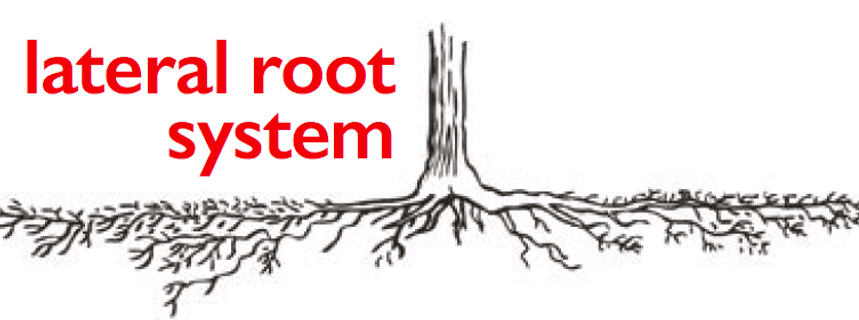
- Absorption roots: These fine roots take in water and nutrients to sustain the tree’s growth.
Since roots are integral to tree health, remember to practice proper tree care, including deep watering, mulching, and tree fertilization. Roots are often damaged by improper planting, so always perform tree planting and transplanting carefully to give roots the best start possible.
Trunk
The trunk is the tree’s main support structure, transporting nutrients and water between the roots and the leaves. It consists of:
- Xylem (heartwood and sapwood): The xylem moves water and nutrients upward from the roots.
- Vascular cambium: This thin layer of cells produces new xylem and phloem, allowing the tree to grow in girth.
- Phloem: This layer transports sugars and nutrients from the leaves to the rest of the tree.
A healthy trunk is crucial for a tree’s stability. Damage from pests, disease, or mechanical injuries (like improper pruning or lawnmower cuts) can weaken a tree and make it more susceptible to failure.
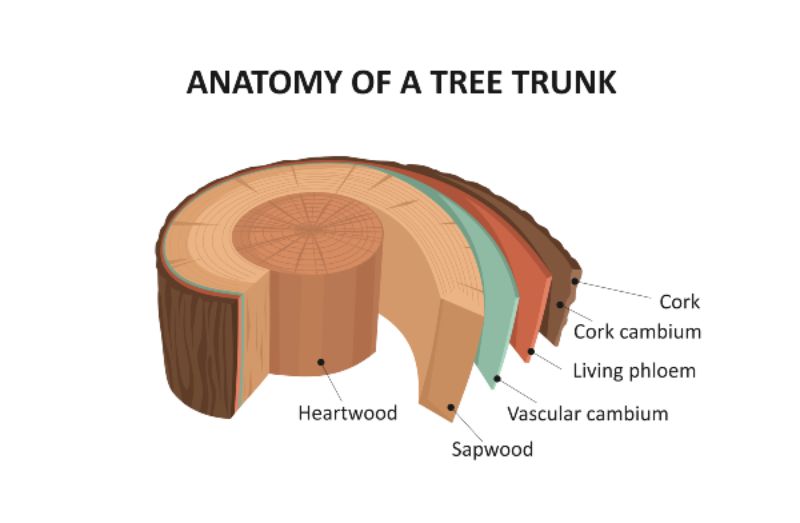
Bark
Bark acts as the tree’s protective shield, guarding it from environmental threats and pests. It consists of:
- Phloem: The inner bark layer that transports nutrients.
- Cork cambium: The layer that produces outer bark.
- Cork: The outermost layer that insulates the tree and prevents water loss.
Proper bark care includes avoiding damage, mulching appropriately, and monitoring for signs of decay or disease. If bark is damaged, it can expose the tree to infections, fungi, and insects.
Branches
Branches extend from the trunk and support the leaves. They are made up of the same wood and bark layers as the trunk and play a key role in tree structure and growth. Tree pruning and trimming help maintain strong, well-balanced branches.
Proper pruning improves tree health by removing dead or diseased branches and reducing the risk of breakage. However, improper pruning can weaken a tree and lead to decay. It’s best to follow correct pruning techniques or hire a certified arborist.
Leaves
Leaves are the tree’s food producers, converting sunlight into energy through photosynthesis. They absorb carbon dioxide, release oxygen, and regulate water loss. Leaves come in various shapes and sizes, depending on the tree species. Their functions include:
- Photosynthesis: Producing energy for the tree.
- Transpiration: Releasing moisture to cool the tree and surrounding air.
- Gas exchange: Absorbing carbon dioxide and releasing oxygen.
Regularly inspecting leaves can help identify tree health issues. Yellowing, browning, or premature leaf drop may indicate stress, disease, or pest problems.
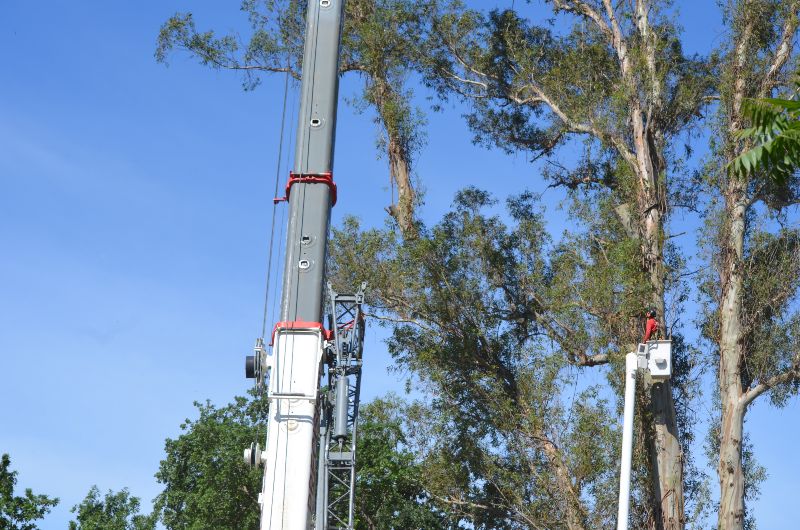
Crown
The crown consists of the tree’s branches and leaves. It plays a key role in absorbing sunlight and regulating the tree’s overall growth. While pruning can slightly modify the crown’s shape, its structure is largely determined by genetics. A well-maintained crown improves the tree’s health and appearance.
Stump
The stump is what remains after a tree is removed. It connects the trunk to the roots and includes the root flare and anchor roots. While some people leave stumps in place, they can become hazards or attract pests. Stump grinding is an effective way to remove unwanted stumps and improve landscape aesthetics.
Using Tree Anatomy to Keep Your Trees Healthy
Understanding tree anatomy helps you detect early signs of trouble and take proactive steps to maintain your trees. Regularly check for symptoms like:
- Wilting or discolored leaves
- Cracks or cavities in the trunk
- Fungal growth on bark or roots
- Dead or broken branches
- Excessive sap flow
If you notice any of these warning signs, consult a tree care professional for assessment and treatment options. Timely intervention can prevent further damage and prolong the life of your tree.
Tree Management and Care
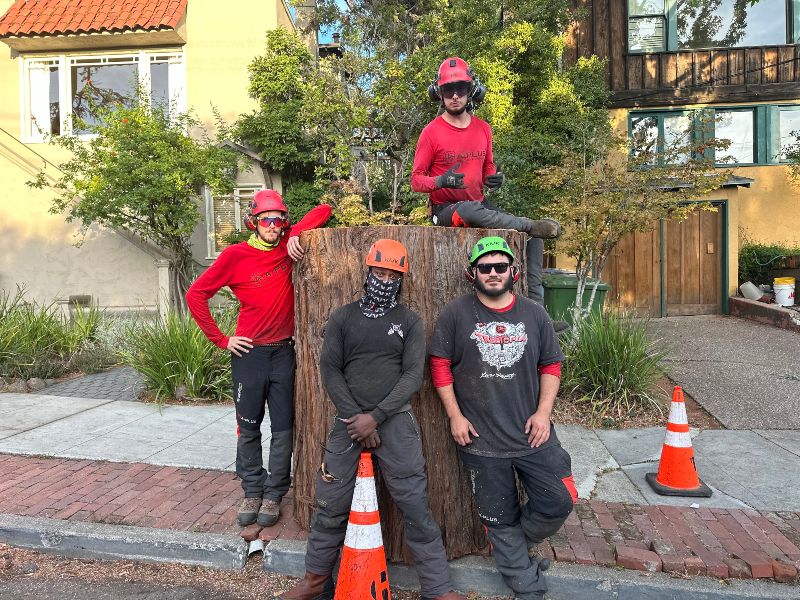
Caring for trees requires knowledge, effort, and expertise. Our tree services, including pruning, fertilization, disease management, and ArborPlus tree management software, help you maintain healthy, thriving trees. By understanding tree anatomy and working with experienced arborists, you can ensure the long-term health of your trees. Contact us for a complimentary assessment, we’re here to support you!


